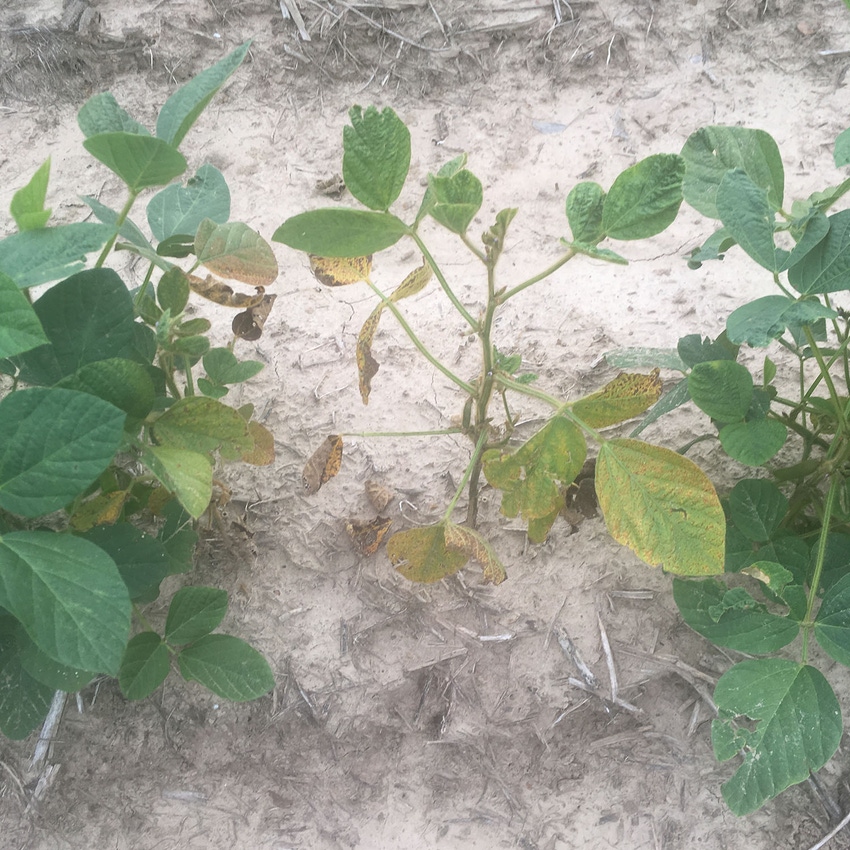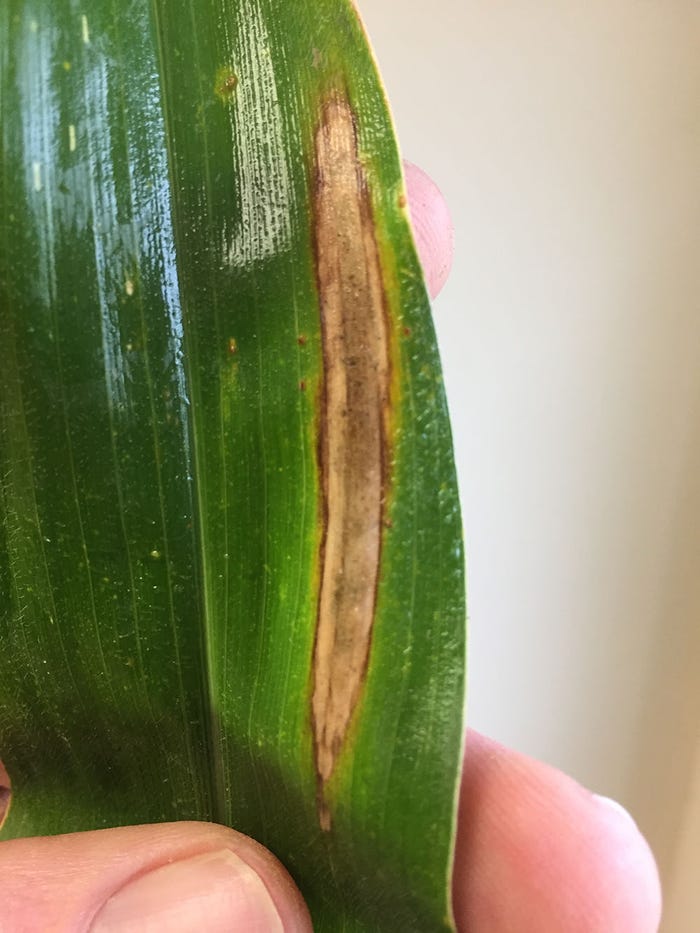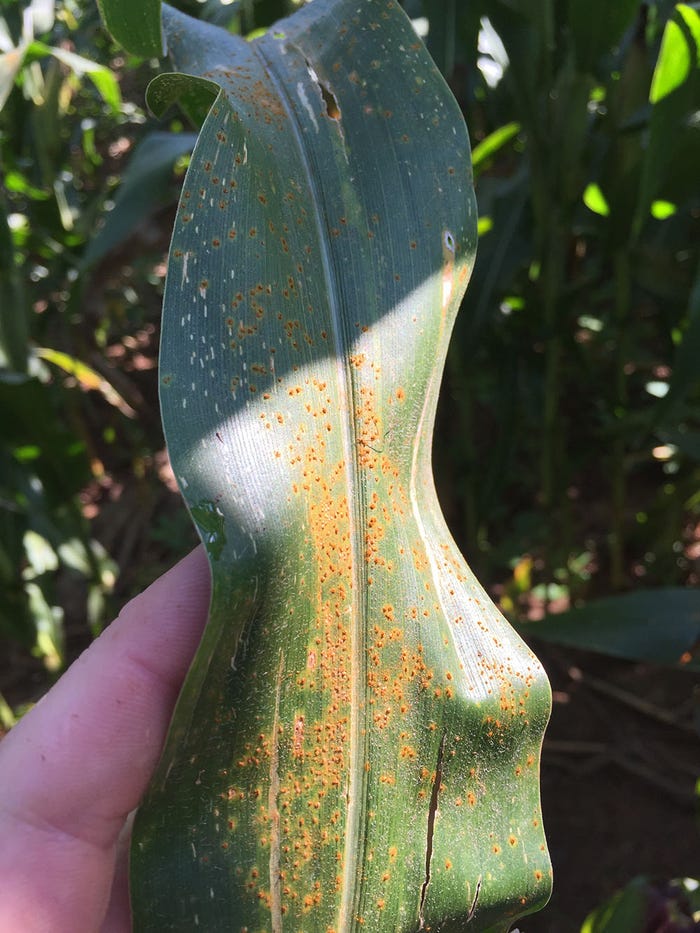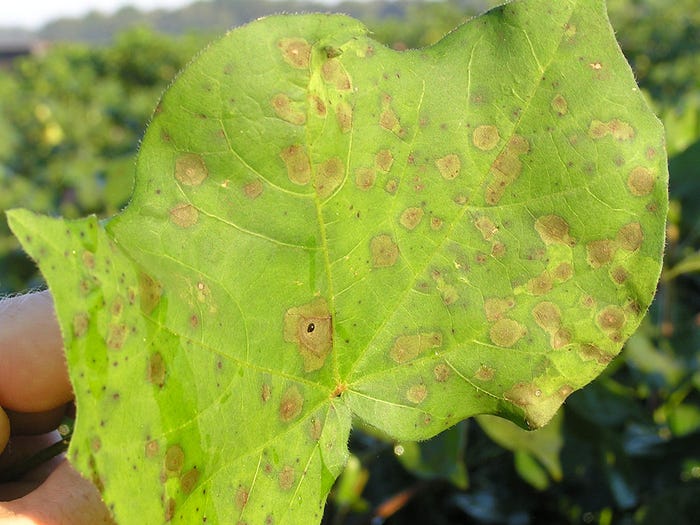
Weather was favorable for an assortment of diseases in Mid-South corn, cotton, and soybeans in 2017. Culprits included northern corn leaf blight, southern rust, target spot, stem canker, Septoria brown spot, and taproot decline.
Here are a few comments on disease impact from state Extension plant pathologists:
LOUISIANA
Corn: Louisiana Plant Pathologist Trey Price began hearing reports of northern corn leaf blight in susceptible hybrids as early as the V6 growth stage, mostly in minimum- or no-till corn. A few producers sprayed fungicides twice for the disease, he says. “Disease pressure was incredible in some areas, and in research trials, we had losses ranging from 20 percent to 30 percent.”
Luckily, the disease wasn’t a widespread issue. “But in fields that aren’t rotated and planted to a susceptible hybrid, it’s going to be an annual problem,” he says. “A lot of the susceptible hybrids have great yield potential, but there are resistant hybrids that have comparable yields, and you don’t have to spray them with a fungicide.”
 Northern corn leaf blight
Northern corn leaf blight

Southern rust appeared in corn around the first of June, Price says, but corn was far enough along for it not to be a threat. A few applications were made in northern Louisiana “because we were picking up some rust around tassel stage or shortly thereafter.”
Soybeans: While disease pressure was high in Louisiana soybeans, there were no widespread catastrophes, Price says. “Frogeye leaf spot was light to moderate; Cercospora blight is ever-present; and aerial blight was also an issue — and it seems to be an annual issue when we get a lot of rainfall.”
Due to fungicide resistance issues for the previously mentioned diseases, “producers are moving toward SDHI compounds and tank mixes with triazoles instead of spraying straight strobilurins. In southwest Louisiana, they don’t have a choice. As far as I know, the SDHIs are still effective on the strobilurin-resistant aerial blight pathogen population.”
Wet weather also brought increased taproot decline, “which occurs where you have soybean monoculture and minimum-till or no-till,” Price says. “Rotation and tillage help, and we’re fairly confident there are some resistant varieties. Hopefully, we can positively identify some of those resistant varieties before producers order seed for next season.”
Weathering in earlier-planted soybeans was an issue during 2017. “When beans are mature during a rainy August/September, it is not a good situation,” he says. “Unfortunately, we’re at the mercy of Mother Nature because fungicides will have minimal effect on weathering. We have rated variety trials over the past two seasons, and some varieties may hold up better than others.”
Cotton: A wet August brought prime conditions for target spot in cotton, Price says. “We probably had a few fields that lost yield to severe target spot. It was a trying year for cotton farmers,” who also lost yield to boll shed during less-than-ideal cotton weather in July and August.
“Producers should consider managing the canopy to avoid both rank growth and target spot,” he says. “Apply your plant growth regulators in a timely fashion, and try to slow down some of these varieties. That also may help for boll rot and hard lock — rank growth and too much nitrogen go hand-in-hand. Follow the recommendations of your cotton specialists for nitrogen rates.”
ARKANSAS
Corn: Extension Plant Pathologist Travis Faske says a tropical storm moved southern rust spores into northeast Arkansas, and many producers had to treat for the disease. “Usually they just outrun it,” he says.
 Southern rust in corn
Southern rust in corn

The treatments were beneficial, with research trials showing a 20 bushel difference between treated and untreated plots.
Soybeans: Arkansas soybean producers got a welcome respite from frogeye leaf spot and target spot in 2017, but a few fields were hit hard with stem canker, particularly where susceptible varieties were planted. Faske says soybean breeders have done a good job in recent years developing varieties with good yield potential and good resistance packages.
Soybean rust has been prevalent too, but hasn’t been a problem. “In the past 13 years, the University of Arkansas has recommended to spray only one time, south of I-40.”
Cotton: Target spot appeared in Arkansas cotton in 2017, but cooler weather slowed it, Faske says.
MISSISSIPPI
Corn: According to Mississippi Extension Plant Pathologist Tom Allen, the 2017 Mississippi corn crop was the cleanest he’s seen in terms of disease. “We had limited amounts of northern corn leaf blight, and a little more common rust than we typically see. But common rust usually sputters out once the temperatures get warm.”
Southern rust came in late, and wasn’t a major concern, he says. “However, if southern rust starts early, sometime around tassel stage, it can be considered extremely problematic.”
Soybeans: For the second year in a row, target spot was an issue in soybeans, Allen says. Because of the pressure, researchers compiled more target spot ratings, and hope to have more information on the disease and fungicide efficacy prior to the 2018 season.
While the incidence of frogeye leaf spot declined in 2017, Septoria brown spot “has definitely been on the increase,” he says. “Like target spot, I attribute Septoria brown spot to a lack of rotation. Most of the disease is happening in continuous soybean production. Minimum tillage is also a factor.”
Another disease to keep an eye on is stem canker, Allen says. “We had some situations this year in which some farmers purchased some highly susceptible soybean varieties, thinking they weren’t going to have an issue. Yield in those situations plummeted to between 10 bushels and 15 bushels because of the stem canker-conducive environment.”
Cotton: Producers reported seeing target spot in their fields again this year, but not to the extent of 2016. But according to Cotton Incorporated-funded trials that have been conducted for multiple years in the Mid-South, management of target spot with fungicides “does not appear to be economically beneficial,” Allen says. “We may have to rethink how we manage the disease in cotton.”
Allen noted that even in Mississippi trials with up to 80 percent defoliation in the lower canopy, there was not a positive response from the fungicide, he says. “It has created a conversation among pathologists and cotton specialists as to whether the defoliation counters the effect of potential yield loss (to boll rot and hard lock) by opening the canopy, allowing some air flow to the bottom of the plant.”
TENNESSEE
Corn: Gray leaf spot appeared in 2017, mostly in continuous corn planted to a susceptible hybrid. In addition, southern rust came in earlier in some fields, but in general was too minor for most producers to make a fungicide application, according to Tennessee Extension Plant Pathologist Heather Kelly.
 Target spot in cotton
Target spot in cotton

Many producers used a three-way mode of action mixture for diseases. Trivapro, which includes a strobilurin (QOI), triazole (DMI), and SDHI (succinate dehydrogenase inhibitor), “is a good product against rust and gray leaf spot,” she says.
Soybeans: The weather was right for an assortment of soybean diseases in Tennessee, including frogeye leaf spot, cercospora leaf blight, target spot, Septoria brown spot, and in certain varieties, charcoal rot, Kelly says. While there are no known varieties resistant to Septoria brown spot, varieties do vary in the level of infection. Similarly, there is little varietal data available on charcoal rot resistance but some varietal information on these diseases and others can be found at search.utcrops.com/disease/.
Soybean rust made its earliest-ever arrival in Tennessee in 2017, beating out last year’s August 29 date by a couple of days. Research plots may show a greater response to fungicides than usual this year, Kelly predicts.
She notes that thiophanate-methyl, the active ingredient in Topsin, appears to now have some efficacy on some diseases, including frogeye leaf spot, due to shifts in sensitivity of fungal pathogens. For more information on modes of action in fungicides, visit FRAC.info and click on Publications.
Cotton: A new player in Tennessee cotton in 2017 was bacterial blight, Kelly says. “I don’t think it impacted yield; the worst fields had low levels of defoliation and low numbers of infested bolls. The primary yield robber from bacterial blight is premature defoliation, which affects yield, and then boll rot.”
Target spot was present in fields, but with not nearly the prevalence and severity of 2016. While a good number of cotton fields were treated with a fungicide, many probably did not benefit from the application, she says.
About the Author(s)
You May Also Like






